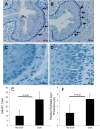Allergen-induced resistin-like molecule-α promotes esophageal epithelial cell hyperplasia in eosinophilic esophagitis
- PMID: 24994859
- PMCID: PMC4154121
- DOI: 10.1152/ajpgi.00141.2014
Allergen-induced resistin-like molecule-α promotes esophageal epithelial cell hyperplasia in eosinophilic esophagitis
Erratum in
-
Allergen-induced resistin-like molecule- promotes esophageal epithelial cell hyperplasia in eosinophilic esophagitis.Am J Physiol Gastrointest Liver Physiol. 2015 Aug 15;309(4):G281. doi: 10.1152/ajpgi.zh3-6953-corr.2015. Am J Physiol Gastrointest Liver Physiol. 2015. PMID: 26276974 Free PMC article. No abstract available.
Abstract
Resistin-like molecule (Relm)-α is a secreted, cysteine-rich protein belonging to a newly defined family of proteins, including resistin, Relm-β, and Relm-γ. Although resistin was initially defined based on its insulin-resistance activity, the family members are highly induced in various inflammatory states. Earlier studies implicated Relm-α in insulin resistance, asthmatic responses, and intestinal inflammation; however, its function still remains an enigma. We now report that Relm-α is strongly induced in the esophagus in an allergen-challenged murine model of eosinophilic esophagitis (EoE). Furthermore, to understand the in vivo role of Relm-α, we generated Relm-α gene-inducible bitransgenic mice by using lung-specific CC-10 promoter (CC10-rtTA-Relm-α). We found Relm-α protein is significantly induced in the esophagus of CC10-rtTA-Relm-α bitransgenic mice exposed to doxycycline food. The most prominent effect observed by the induction of Relm-α is epithelial cell hyperplasia, basal layer thickness, accumulation of activated CD4(+) and CD4(-) T cell subsets, and eosinophilic inflammation in the esophagus. The in vitro experiments further confirm that Relm-α promotes primary epithelial cell proliferation but has no chemotactic activity for eosinophils. Taken together, our studies report for the first time that Relm-α induction in the esophagus has a major role in promoting epithelial cell hyperplasia and basal layer thickness, and the accumulation of activated CD4(+) and CD4(-) T cell subsets may be responsible for partial esophageal eosinophilia in the mouse models of EoE. Notably, the epithelial cell hyperplasia and basal layer thickness are the characteristic features commonly observed in human EoE.
Keywords: eosinophils; epithelial cells; esophagus.
Copyright © 2014 the American Physiological Society.
Figures







References
-
- Akei HS, Mishra A, Blanchard C, Rothenberg ME. Epicutaneous antigen exposure primes for experimental eosinophilic esophagitis in mice. Gastroenterology 129: 985–994, 2005 - PubMed
-
- Arora AS, Yamazaki K. Eosinophilic esophagitis: asthma of the esophagus? Clin Gastroenterol Hepatol 2: 523–530, 2004 - PubMed
-
- Banerjee RR, Lazar MA. Dimerization of resistin and resistin-like molecules is determined by a single cysteine. J Biol Chem 276: 25970–25973, 2001 - PubMed
-
- Beltowski J. Adiponectin and resistin–new hormones of white adipose tissue. Int Med J Exp Clin Res 9: RA55–RA61, 2003 - PubMed
-
- Blagoev B, Kratchmarova I, Nielsen MM, Fernandez MM, Voldby J, Andersen JS, Kristiansen K, Pandey A, Mann M. Inhibition of adipocyte differentiation by Resistin like molecule alpha (RELM alpha): biochemical characterization of its oligomeric nature (Abstract). J Biol Chem 19: 19, 2002 - PubMed
Publication types
MeSH terms
Substances
Grants and funding
LinkOut - more resources
Full Text Sources
Other Literature Sources
Medical
Molecular Biology Databases
Research Materials
Miscellaneous

